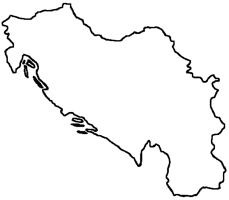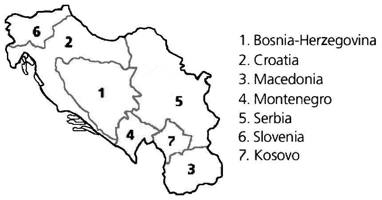
|
The Society of Folk Dance Historians (SFDH)
Yugoslavia
Home |
About |
Encyclopedia | CLICK AN IMAGE TO ENLARGE |

|
BACKGROUND
Information: A former country.
Yugoslavia was a country situated at the crossroads of Central and Southeast Europe in the southern Pannonian Plain and the central Balkans. Yugoslavia borders Hungary to the north; Romania and Bulgaria to the east; Macedonia to the south; Kosovo to the southwest, Bosnia-Herzegovina and Montenegro to the southwest, and Croatia to the northwest.
On the eve of World War I, Austria-Hungary became wary of the rising regional power on its borders and its potential to become an anchor for unification of all South Slavs, and the relationship between the two countries became tense. The assassination of Archduke Franz Ferdinand of Austria on June 28, 1914 in Sarajevo by Gavrilo Princip, a member of the Young Bosnia Organization, led to Austria-Hungary declaring war on Serbia. In defense of Serbia, and to maintain her status as a Great Power, Russia mobilized its troops, which resulted in Austria-Hungary's ally Germany declaring war on Russia.
In 1941, in spite of Yugoslav attempts to remain neutral in the war, the Axis powers invaded Yugoslavia. The territory of modern Serbia was divided between Hungary, Bulgaria, Croatia, and Italy (greater Albania and Montenegro), while the remaining part of Serbia was placed under German military administration, with Serbian puppet governments.
A nationalism broke across Yugoslavia that eventually resulted in its breakup, with Slovenia, Croatia, Bosnia-Herzegovina, and Macedonia declaring independence. Serbia and Montenegro remained together as the Federal Republic of Yugoslavia. In 2008, Kosovo and Montenegro declared independence from Serbia.
Other name: Jugoslavia
Location: Balkans
Languages: Various
Religions: Various
FORMER YUGOSLAV COUNTRY INDEPENDENCE DECLARATIONS

- Bosnia-Herzegovina – 1992
- Croatia – 1992
- Macedonia – 1993
- Montenegro – 2008
- Serbia – 2008
- Slovenia – 1992
- Kosovo – 2008
DOCUMENTS
- About Ličko Kolo, a dance.
- Ajšino Oro, a dance.
- Balkan and Israeli Folk Dances, a book.
- Balkan Religions, an article.
- Balkans, a region.
- Belasičko Oro, a dance.
- Biserka-Bojerka, a dance.
- Bora Gajicki, an article.
- Boris Karlov, an article.
- Bosnia, a country.
- Bruno Records, a recording company.
- Bulgaria, a country.
- Bulgaria and Its Dances, an article.
- Capitol Records, a recording company.
- Ciga and Ivon Despotović, an article.
- Congress on Research in Dance, an organization.
- Costumes, an article.
- Croatia, a country.
- Dennis Boxell, an article.
- Dick Crum, an article.
- Dick Oakes, an article.
- Eddy Nadel, an article.
- Elsie Dunin, an article.
- Fatiše Kolo, a dance.
- Grace Newman, a lyricist.
- John Filcich, an article.
- Igra Kolo: Dance Kolos with John Filcich, a book.
- Inner Joy of Yugoslav Dancing, an article.
- Isn't it Too Bad that the Old Dances are Dying Out?, an article.
- Jeftanovićevo Kolo, a dance.
- Jugodisk, a recording company.
- Jugoton, a recording company.
- Kokonješte, a dance.
- Kolo, Some Background, an article.
- Kosovo, a country.
- Leilam, a dance.
- Ljubica and Danica Janković, an article.
- Macedonia, a country.
- Macedonian Dances of Promahi, an article.
- Makazice, a dance.
- Martin Koenig, an article.
- Monitor Records, a recording company.
- Montenegro, a country.
- National Geographic Magazine Folklore Index 1914-1997, a list.
- Opsa, a dance.
- Paiduško Horo, a dance.
- Prekid Kolo, a dance.
- Robert Leibman, an article.
- Ron Wixman, an article.
- RTB Records, a recording company.
- Rumelaj, a dance.
- Serbia, a country.
- Skopska Crnagorka, a dance.
- Slovenia, a country.
- St. George's Day, an article.
- Steve Kotansky, an article.
- Survival or Extinction, an article.
- Tino Mori, a dance.
- Tsveta Moma Ubava, a song.
- U Šest Koraka, a dance.
- Vladimir Đorđevič, an article.
- Vyts Beliajus, an article.
- Žikino Kolo, a dance.
This page © 2018 by Ron Houston.
Please do not copy any part of this page without including this copyright notice.
Please do not copy small portions out of context.
Please do not copy large portions without permission from Ron Houston.